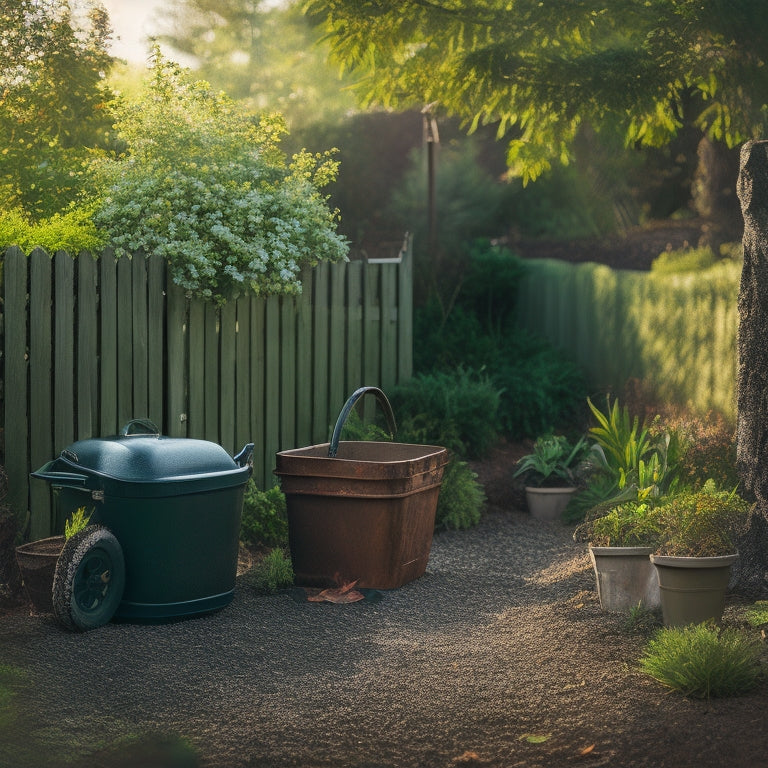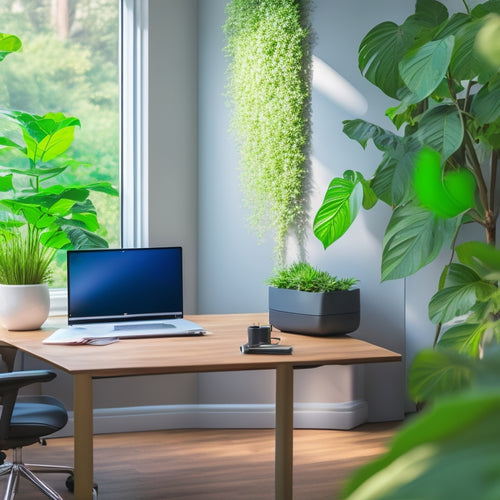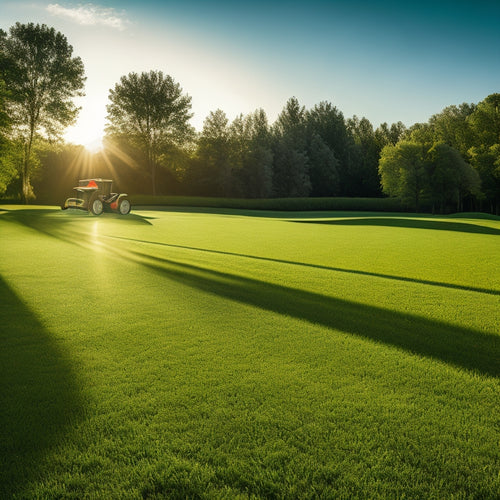
10 Green Waste Solutions Every Homeowner Should Know
Share
You can make a significant impact on the environment by implementing green waste solutions at home. Consider composting toilets, which reduce water consumption and produce nutrient-rich compost. Vermicomposting and DIY compost bins are also effective ways to manage kitchen scraps and yard waste. Effective food waste recycling methods, such as bokashi composting, can further minimize your waste output. Additionally, green waste management for landscaping, biogas generation, and implementing a zero waste lifestyle can all contribute to a more sustainable living space. By exploring these solutions, you'll be well on your way to reducing your carbon footprint and creating a more eco-friendly home.
Key Takeaways
- Composting toilets significantly reduce water consumption and produce nutrient-rich compost, contributing to energy independence and reduced greenhouse gas emissions.
- Vermicomposting with worms breaks down food scraps and yard waste, producing a nutrient-rich compost for gardening while reducing landfill waste.
- DIY compost bins can be easily assembled and maintained, utilizing materials like wooden pallets and drills, to convert organic waste into a valuable resource.
- Effective odor control in compost bins is achieved through proper aeration, moisture levels, and material balance, eliminating unpleasant smells and promoting healthy decomposition.
- Implementing green waste management strategies, such as converting yard trimmings into mulch, reduces chemical runoff, promotes healthy plant growth, and minimizes landfill waste.
Composting Toilets for Eco-Friendly Homes
About one-third of residential water usage goes towards flushing toilets, making them a significant contributor to your home's water footprint.
By switching to composting toilets, you can drastically reduce your water consumption and create a more sustainable sanitation system. Composting toilets break down human waste into a useful compost, eliminating the need for chemical-laden fertilizers and providing a natural alternative for gardening.
Additionally, adopting sustainable practices like reducing reliance on fossil fuels energy independence can have a significant impact on the environment. This eco-friendly solution not only conserves water but also reduces your reliance on municipal sewage systems.
With composting benefits like reduced greenhouse gas emissions and nutrient-rich soil amendments, you'll be taking a significant step towards a more environmentally conscious lifestyle.
Reduce Waste With Vermicomposting
As you investigate deeper into the world of green waste solutions, vermicomposting emerges as a highly effective method for reducing organic waste.
By utilizing the power of worms, you can break down food scraps and yard waste into a nutrient-rich compost.
Vermicomposting benefits include a significant reduction in waste sent to landfills, minimized greenhouse gas emissions, and the creation of a natural fertilizer for your garden.
In addition, incorporating renewable energy sources like solar-powered fast charging into your waste management strategy can further reduce your carbon footprint.
This worm composting process is a low-maintenance and odor-free way to recycle organic matter, making it an attractive solution for environmentally conscious homeowners.
DIY Compost Bins for Kitchen Scraps
You're now ready to set up a DIY compost bin for your kitchen scraps, and the first step is to choose a location that's convenient and accessible.
When assembling your bin, you'll want to take into account easy-to-follow methods that guarantee a sturdy structure.
As companies like Anheuser-Busch's electric trucks are reducing their carbon footprint, you can do your part by reducing waste through composting.
Bin Location Options
Your DIY compost bin for kitchen scraps requires a strategic location to guarantee effortless maintenance and ideal decomposition. Consider the following factors when selecting a location: proximity to your kitchen, bin accessibility, and neighborhood guidelines.
| Location | Pros | Cons |
|---|---|---|
| Under the kitchen sink | Convenient for scraps addition | May attract pests, odors |
| Near the garden | Easy to transfer compost | May be far from kitchen, inconvenient |
| In a shaded area | Cooler temperatures, less odors | May be hard to access, forgotten |
Choose a location that balances convenience, accessibility, and neighborhood regulations to guarantee successful composting.
Easy Assembly Methods
With your bin location decided, it's time to focus on building your DIY compost bin. You'll be glad to know that easy assembly methods make it possible to set up your bin quickly.
For instance, optimizing your solar panel array design solar panel array can also help you reduce energy waste and increase efficiency in your home. Similarly, selecting energy-efficient equipment can minimize energy losses and reduce operating costs.
To get started, you'll need:
- A wooden pallet or wire mesh enclosure
- A drill with screws or wire for assembly
- Some chicken wire or hardware cloth for aeration
Follow a simple design, and you'll have a functional compost bin in no time. Look for plans that offer quick setup, and don't be afraid to get creative with materials you have on hand.
With easy assembly, you'll be composting kitchen scraps in no time, enjoying the freedom to reduce your waste and create nutrient-rich soil for your garden.
Odor Control Tips
Three key factors contribute to unpleasant odors in DIY compost bins: excessive moisture, inadequate aeration, and improper carbon-to-nitrogen ratios. To combat these issues, you can use odor neutralizers or scent masking techniques. For example, adding a 1-inch layer of finished compost or worm castings can help neutralize odors. You can also try adding odor-absorbing materials like activated charcoal or baking soda.
| Odor Control Methods | Effectiveness |
|---|---|
| Odor Neutralizers (e.g., finished compost, worm castings) | High |
| Scent Masking (e.g., essential oils, herbs) | Medium |
| Aeration and Mixing | High |
Remember to maintain a balance of "green" and "brown" materials, guarantee adequate airflow, and turn your compost regularly to prevent unpleasant odors. By following these tips, you can keep your DIY compost bin smelling fresh and healthy.
Effective Food Waste Recycling Methods
How can you divert a significant portion of your household waste from landfills and turn it into a worthwhile resource? By adopting effective food waste recycling methods, you can reduce your environmental footprint and create a useful nutrient-rich soil amendment for your garden.
As companies are increasingly adopting green hydrogen fuel cells to reduce their carbon footprint, homeowners can also make a positive impact by implementing sustainable practices in their daily lives. Additionally, implementing renewable energy solutions can lead to significant cost savings and contribute to a cleaner, more sustainable environment.
-
Kitchen Composting: Collect food scraps in a designated bin and mix them with brown materials like leaves or shredded newspaper. The resulting compost can be used to fertilize your plants.
-
Vermicomposting: Use worms to break down food waste in a controlled environment. This method is ideal for small spaces and produces a high-quality compost.
-
Bokashi Composting: Ferment food waste using microorganisms, then bury the fermented mixture in your garden to create a nutrient-rich soil amendment.
Green Waste Management for Landscaping
You can considerably reduce the amount of waste sent to landfills by adopting effective green waste management strategies for your outdoor environment needs.
One approach is to convert yard trimmings into nutrient-rich ground cover mulch, which helps retain soil moisture and suppress weeds.
Additionally, using organic fertilizers made from composted green waste can promote healthy plant growth while reducing chemical runoff.
Recycling Grey Water at Home
As you implement green waste management strategies in your outdoor environment, it's equally important to contemplate the water used in your household.
Grey water, which is wastewater generated from sinks, showers, and washing machines, can be recycled and reused for irrigation purposes. This not only reduces your water bill but also minimizes the amount of wastewater discharged into the environment.
To recycle grey water at home, you'll need:
- A grey water filtration system to remove contaminants and pathogens.
- A storage tank to hold the treated grey water.
- A sustainable irrigation system to distribute the recycled water to your plants and gardens.
Biogas Generation From Organic Waste
You're likely familiar with the idea of converting waste into energy, but did you know that organic waste can be specifically tapped to generate biogas?
This process relies on the anaerobic breakdown of organic matter, which releases methane and carbon dioxide gases that can be captured and employed.
Waste to Energy Conversion
Its potential to reduce greenhouse gas emissions and generate renewable energy makes waste-to-energy conversion an attractive solution for homeowners looking to manage their organic waste sustainably.
By utilizing the biogas produced from organic waste, you can improve waste efficiency and increase energy recovery. Here's how:
-
Anaerobic Digestion: Microorganisms break down organic matter in the absence of oxygen, producing biogas (a mixture of methane and carbon dioxide).
-
Biogas Upgrading: The biogas is processed to remove impurities, resulting in a high-quality fuel suitable for energy generation.
-
Energy Generation: The upgraded biogas is used to power generators, producing electricity and heat for your home.
Organic Matter Breakdown Process
During the anaerobic digestion process, microorganisms thrive in oxygen-free environments, where they feed on organic waste and break it down into simpler compounds.
You'll notice that microbial activity accelerates as microorganisms convert complex organic matter into carbon dioxide, water, and biogas. This process is essential for nutrient cycling, as it releases vital nutrients like nitrogen, phosphorus, and potassium back into the environment.
As organic matter breaks down, you'll observe a significant reduction in waste volume and mass. The resulting biogas, primarily composed of methane and carbon dioxide, can be utilized as a renewable energy source or used as a natural fertilizer.
Anaerobic Digestion Methods
Your search for effective anaerobic digestion methods to generate biogas from organic waste leads you to various techniques that optimize the breakdown process.
These methods utilize the power of anaerobic microorganisms to convert organic matter into biogas, a mixture of methane and carbon dioxide.
To enhance biogas production, you can employ the following techniques:
-
Batch digestion: This involves adding organic waste to a digester and allowing it to break down in a single batch, resulting in a consistent biogas output.
-
Continuous digestion: In this method, organic waste is continuously fed into the digester, promoting a steady biogas production rate.
-
Co-digestion: This technique involves combining different types of organic waste to create a nutrient-rich feedstock, leading to increased biogas production and efficiency.
Implementing Zero Waste Lifestyle
About 70% of waste generated at home can be attributed to green waste, making it a significant contributor to landfill waste.
To tackle this issue, you can start by implementing a zero-waste lifestyle. This begins with sustainable shopping habits, where you choose products with minimal packaging and avoid single-use plastics.
You'll also need to adopt mindful consumption, buying only what you need and avoiding impulse purchases. By doing so, you'll reduce the amount of waste generated in your home.
Additionally, consider buying second-hand items, repurposing old materials, and composting food waste.
These small changes will add up to make a significant impact on reducing your carbon footprint and promoting a more sustainable future.
Smart Waste Segregation Techniques
You'll considerably reduce contamination and increase recycling efficiency by sorting waste right away, rather than letting it accumulate.
Using color-coded bins also helps you quickly identify where each type of waste goes, making segregation a breeze.
Sort It Right Away
By implementing smart waste segregation techniques, homeowners can greatly reduce the amount of green waste sent to landfills, thereby minimizing environmental harm.
You can start by separating organic waste from inorganic waste. This simple act of waste separation can substantially reduce the amount of waste that ends up in landfills, allowing you to reap the recycling benefits.
Here are three ways to sort your waste effectively:
- Designate a compost bin for food scraps, yard trimmings, and other organic waste.
- Use separate bins for recyclable materials like paper, plastic, glass, and metal.
- Keep a "landfill-bound" bin for non-recyclable waste, like diapers and sanitary products.
Color-Coded Bins Work
Implementing a color-coded bin system can take your waste segregation to the next level. This smart approach to waste management allows you to efficiently organize your waste into separate categories, making it easier to recycle and reduce waste.
With a color-coded system, you can designate specific bins for different types of waste, such as paper, plastic, glass, and organic waste. The color-coded benefits are numerous, including reduced contamination rates, increased recycling rates, and a more streamlined waste collection process.
Designate Waste Zones
Waste zones, designated areas for specific types of waste, are an essential component of smart waste segregation techniques.
By setting up designated disposal areas, you can efficiently implement waste reduction strategies and reduce the likelihood of contamination.
-
Kitchen Waste Zone: Designate a specific area for food waste, vegetable scraps, and coffee grounds.
-
Recyclable Waste Zone: Create a zone for paper, plastic, glass, and metal recyclables.
-
Organic Waste Zone: Set up a zone for yard trimmings, leaves, and branches.
Natural Pest Control Through Waste
Through the decomposition process, microorganisms in green waste break down organic matter, releasing volatile compounds that repel pests.
You can utilize this natural process to create effective pest deterrents. By allowing certain types of green waste to decompose, you'll create natural repellents that can be used to keep unwanted critters out of your garden or yard.
For example, decomposed neem leaves can be used to repel mosquitoes and other insects. Similarly, crushed garlic and hot peppers can be added to compost to create a natural pest control solution.
Frequently Asked Questions
Can I Compost Pet Waste and Diapers at Home?
As you gaze upon your furry friend's twinkling eyes, you wonder: can you compost their waste at home? Unfortunately, no - pet waste composting is a health risk due to pathogens; instead, investigate safe diaper disposal options, like specially designed bins or eco-friendly absorbent products.
Are All Types of Plastics Recyclable in Green Waste Management?
You'll find that not all types of plastics are recyclable; some, like bioplastics and composite materials, can't be processed by traditional plastic recycling facilities, so it's vital to understand what's accepted in your local plastic recycling program.
How Often Should I Turn My Compost Pile for Optimal Decomposition?
You should turn your compost pile every 7-10 days for ideal decomposition, ensuring proper compost aeration techniques and regular compost pile maintenance to facilitate efficient breakdown of organic matter and release of nutrients.
Can I Use Compost Tea as a Natural Fertilizer for Indoor Plants?
You can employ compost tea as a natural fertilizer for indoor plants, reaping benefits like enhanced soil microbiome, improved plant growth, and increased resistance to disease, while promoting a chemical-free indoor plant care approach that aligns with your values of freedom and sustainability.
Do Green Waste Solutions Require a Large Outdoor Space?
You're wondering if going green means sacrificing precious outdoor space, but fear not! With container gardening and urban composting, you can turn even the smallest areas into thriving ecosystems, freeing you from spatial constraints and nurturing your plants.
Related Posts
-

7 Best Home Hydrogen Fuel Cells for Clean Power
You're considering adopting hydrogen fuel cells for clean power at home, but you want to know the best options. Reput...
-

10 Best Energy-Efficient External Hard Drives for Sustainable Offices
When it comes to sustainable offices, you need external hard drives that balance data storage needs with energy effic...
-

10 Powerful Electric Mowers for Expansive Lawns
You're moving away from gas-powered mowers and exploring electric options for your expansive lawn. You'll find that h...


